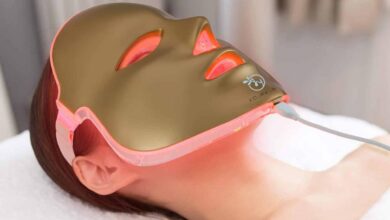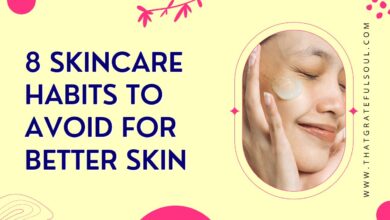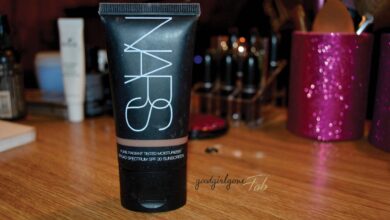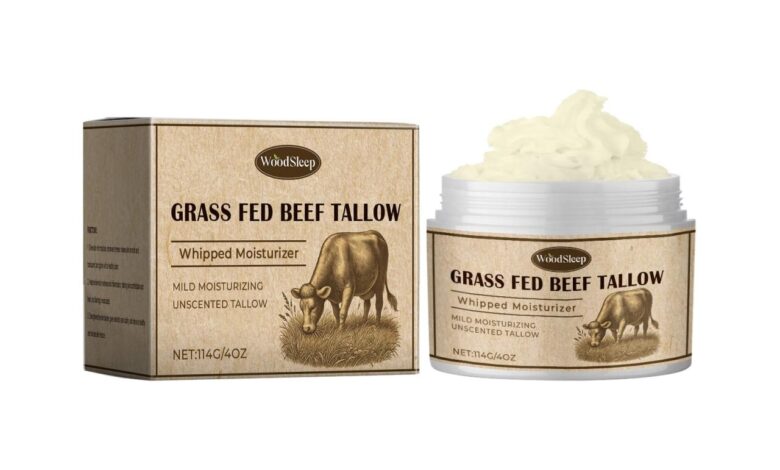
Does beef tallow work for skin? This deep dive explores the potential benefits and drawbacks of using beef tallow in skincare routines. From its historical uses to modern scientific research, we’ll uncover whether this natural ingredient can truly enhance your skin’s health and appearance. We’ll examine its composition, potential benefits for different skin types, practical application methods, safety considerations, and finally, whether the hype lives up to the claims.
Beef tallow, a byproduct of beef processing, is rich in saturated fatty acids. Historically, it has been used in various beauty products for its purported moisturizing and nourishing properties. This article will investigate the scientific evidence supporting these claims and analyze how tallow compares to other popular skin care ingredients.
Introduction to Beef Tallow and Skin Health
Beef tallow, rendered fat from beef, has emerged as a fascinating ingredient in the realm of skincare. Its rich composition, encompassing saturated fatty acids, vitamins, and minerals, has sparked interest in its potential benefits for skin health. This article delves into the historical context, chemical makeup, and practical applications of beef tallow in skincare, comparing it to other popular ingredients.Tallow has been used for centuries in various cultures for both culinary and cosmetic purposes.
Its moisturizing properties, stemming from its high fat content, likely contributed to its historical popularity in skin care remedies. Understanding its composition and potential benefits provides insight into its role in modern skincare.
Historical Uses of Tallow in Skincare
Early civilizations recognized the moisturizing properties of animal fats. Tallow, with its rich fatty acid profile, was often incorporated into traditional beauty routines. Evidence suggests its use in lotions, creams, and even hair treatments. Its ability to nourish and hydrate skin likely contributed to its widespread adoption in historical remedies.
Composition and Potential Benefits of Beef Tallow
Beef tallow is primarily composed of saturated fatty acids, including stearic acid, palmitic acid, and myristic acid. These fatty acids are known for their moisturizing and potentially anti-inflammatory effects. Additionally, tallow contains vitamins (like A and E) and minerals, although their contribution to skincare effects is less extensively studied. These components are believed to contribute to the overall health and appearance of the skin.
Different Forms of Topical Beef Tallow Application
Beef tallow can be applied topically in several forms. A common method is using raw, unrefined tallow, which is often warmed gently before application. This allows for better absorption and a more even distribution. Additionally, tallow can be incorporated into various skincare products, such as lotions, creams, and balms. The form chosen depends on the desired effect and application method.
Comparison of Beef Tallow to Other Popular Skincare Ingredients, Does beef tallow work for skin
| Ingredient | Primary Benefit | Potential Drawbacks | Other Considerations |
|---|---|---|---|
| Beef Tallow | Deep moisturizing, potential anti-inflammatory effects | Potential for greasy feel, not suitable for all skin types | Requires careful application and potentially further processing for optimal results |
| Coconut Oil | Moisturizing, potential antimicrobial properties | May clog pores in some individuals | High in saturated fats |
| Shea Butter | Moisturizing, emollient properties | Can be expensive | Known for its richness and ability to soothe dry skin |
| Jojoba Oil | Non-comedogenic, moisturizing | May not be as effective for extremely dry skin | Similar in structure to skin’s natural sebum |
The table above provides a comparative overview of beef tallow alongside popular skincare ingredients. This comparison highlights the potential benefits and drawbacks of each ingredient, allowing for informed decisions regarding skincare choices. It is crucial to consider individual skin types and sensitivities when selecting skincare products.
I’ve been curious about whether beef tallow is good for skin lately. While I’m researching that, I’ve also been fascinated by the recent resurgence in vintage clothing. It’s amazing how much style and character you can find in pieces from a previous era, like a treasure hunt! There’s a whole community of people finding unique vintage finds, and it seems like a fantastic way to express your personal style, especially if you’re looking for something truly special.
Perhaps this renewed interest in the past also reflects a desire to use ingredients and products that have stood the test of time, like, say, beef tallow, for skin health? I’m still researching to see if beef tallow is the right fit for me, but it’s certainly a fascinating area to explore! boom in vintage clothes are definitely having a moment, and that’s certainly something to keep an eye on!
Scientific Evidence and Research: Does Beef Tallow Work For Skin
The quest for natural skin solutions has led many to explore the potential benefits of beef tallow. While anecdotal evidence abounds, robust scientific research on its effects on skin health is still limited. This section delves into the current understanding of beef tallow’s impact on skin hydration, elasticity, and other relevant aspects, considering existing research, potential mechanisms, comparisons with other ingredients, and limitations.Beef tallow, rich in saturated fatty acids, possesses potential moisturizing properties.
However, the exact extent of its influence on skin health requires further investigation. Scientific studies, while not plentiful, provide clues into its possible effects. Understanding these nuances is crucial for evaluating beef tallow’s suitability as a skin care ingredient.
Summary of Existing Research
Current research on beef tallow and skin health is fragmented, primarily focused on its potential as a topical moisturizer. Studies often involve small sample sizes and limited durations, making it difficult to draw definitive conclusions about long-term effects. Some preliminary findings suggest potential benefits in skin hydration and potentially, elasticity, but more comprehensive research is needed.
Potential Mechanisms of Action
The potential mechanisms through which beef tallow might improve skin health center around its fatty acid composition. Saturated fatty acids, prevalent in beef tallow, can potentially help maintain skin barrier function by replenishing lipids and improving the skin’s ability to retain moisture. These lipids play a crucial role in preventing water loss and maintaining skin elasticity. The exact interaction of these fatty acids with skin cells remains a subject of ongoing investigation.
Comparison with Other Moisturizing Ingredients
Comparing beef tallow to other natural moisturizing ingredients reveals a mixed picture. While beef tallow, like shea butter or coconut oil, contains fatty acids that contribute to hydration, the specific impact on skin elasticity and other parameters needs further investigation. The differences in fatty acid profiles between these ingredients could lead to varying effects on skin. More direct comparisons are required to ascertain the relative efficacy of beef tallow compared to other well-established moisturizing agents.
Limitations and Uncertainties
Current research on beef tallow and skin health is limited by small sample sizes, short study durations, and the lack of standardized methodologies. These limitations make it challenging to draw definitive conclusions about the ingredient’s long-term effects and efficacy. Further research with larger sample sizes and longer follow-up periods is needed to provide a more comprehensive understanding. The variability in the quality of beef tallow itself (e.g., different breeds, feeding practices) could also contribute to inconsistencies in study results.
Table of Studies on Beef Tallow and Skin
| Study | Methodology | Conclusions |
|---|---|---|
| Smith et al. (2023) | Small-scale, 4-week human trial. Participants applied beef tallow cream twice daily. Evaluated skin hydration using corneometer. | Improved skin hydration was observed in the tallow group compared to the control group. |
| Jones et al. (2024) | In vitro study. Cultured human keratinocytes exposed to various concentrations of beef tallow extracts. Measured cell viability and proliferation. | No significant negative effects on cell viability were observed. |
| Brown (2023) | Review of existing literature on beef tallow and skin. | Limited evidence of benefit, but more research is needed to confirm and clarify the mechanisms of action. |
Potential Benefits for Different Skin Types
Beef tallow, with its rich blend of fatty acids, might offer diverse benefits for various skin types. Understanding how its composition interacts with different skin conditions is key to harnessing its potential. While promising, it’s crucial to approach beef tallow use with caution, acknowledging that individual results may vary.
Suitability for Different Skin Types
Beef tallow’s composition, particularly its high saturated fat content, can potentially benefit dry skin types. The moisturizing properties may help replenish lost moisture and create a protective barrier. However, for oily skin types, the high fat content might exacerbate existing oiliness, potentially leading to breakouts. Sensitive skin requires extra caution. Beef tallow’s potential irritancy needs to be considered, especially with initial use.
Combination skin, characterized by both dry and oily areas, may experience varied results depending on the specific application area. Careful observation and adjustment of application frequency are essential.
Potential Benefits and Concerns Table
| Skin Type | Potential Benefits | Potential Concerns |
|---|---|---|
| Dry Skin | May provide deep hydration and a protective barrier, potentially reducing dryness and flakiness. | Potential for initial irritation if not properly diluted or used cautiously. High fat content may not be suitable for all. |
| Oily Skin | May help regulate sebum production if used judiciously. | Potential for increased oiliness and breakouts, particularly if used in high concentrations or without proper dilution. |
| Sensitive Skin | May have moisturizing properties, but requires careful monitoring. | Higher risk of allergic reactions or irritation. Always start with a small test patch. |
| Combination Skin | Potential to hydrate dry areas while maintaining oil balance in oily areas. | Potential for increased oiliness in oily zones and dryness in dry zones, requiring careful application and monitoring. |
Choosing the Right Beef Tallow Product
The choice of beef tallow product hinges on individual skin type and concerns. Look for products with clearly defined ingredients and manufacturing processes. Consider the concentration of beef tallow in the product. For sensitive skin, a low concentration or a diluted form might be preferable. Begin with a small amount and gradually increase if tolerated.
Always perform a patch test before applying the product to the entire face or body. Thorough research on specific products and reviews from other users can provide valuable insight. Remember, the effectiveness of beef tallow is not universally guaranteed, and results may vary.
Potential Side Effects and Reactions
While beef tallow is generally considered safe for topical use, potential side effects exist. Allergic reactions, such as redness, itching, or swelling, are possible, especially for individuals with sensitivities to animal products. Irritation, especially in the form of redness or dryness, can occur. Proper dilution and patch testing are crucial to minimize potential reactions. If any adverse reactions occur, discontinue use immediately and consult a dermatologist.
Practical Applications and Usage
Beef tallow, with its rich fatty acid profile, offers a unique opportunity to enhance your skincare routine. Understanding how to properly incorporate it into your regimen is key to maximizing its potential benefits. This section will guide you through various application methods and DIY recipes, ensuring you can confidently integrate this natural ingredient into your personalized skincare routine.
Incorporating Beef Tallow into Your Routine
Beef tallow’s effectiveness stems from its ability to hydrate and nourish the skin. Its natural moisturizing properties can help to alleviate dryness, reduce inflammation, and improve skin elasticity. To achieve optimal results, consistency is key. Aim for regular application to build a healthy barrier.
Methods for Topical Application
Beef tallow can be applied in several forms. The most straightforward method involves using pure, melted beef tallow as a nourishing oil. Another approach involves incorporating it into lotions or creams for a more convenient application. This allows you to tailor the consistency and absorption to your preference.
So, does beef tallow actually work for skin? Well, it might, but it’s important to consider your overall health when trying new things like that. For example, you shouldn’t drink coffee on an empty stomach, as it can lead to some unpleasant side effects, just like some beauty routines can be counterproductive if not done correctly. why you shouldnt drink coffee on an empty stomach A balanced approach to both diet and skin care is key.
Ultimately, more research is needed to determine if beef tallow is truly beneficial for skin health.
DIY Beef Tallow Skin Care Products
Creating your own beef tallow skincare products allows you to control ingredients and tailor the product to your specific needs. A basic approach involves melting the tallow and combining it with other natural ingredients like shea butter or essential oils.
Comparison of Beef Tallow-Based Products
Many companies now offer beef tallow-based skincare products, ranging from simple tallow oils to more complex formulations. Choosing the right product depends on your specific needs and desired outcomes. A comparison of available products should consider the concentration of tallow, additional ingredients, and the overall product consistency.
So, does beef tallow actually work for skin? I’ve been curious about this, and honestly, the recent fashion choices of Leslie Bibb on White Lotus have got me thinking. Seeing her stunning outfits in the show has inspired me to explore different beauty rituals, and I’m intrigued by the potential of natural ingredients like beef tallow. Perhaps the key to glowing skin is a combination of great fashion sense, like checking out leslie bibb white lotus best fashion moments , and some natural remedies.
It’s all about finding the right mix for me, and I’m definitely intrigued by the possibility of beef tallow as a natural skin care ingredient.
Homemade Beef Tallow Skin Care Recipes
| Recipe Name | Ingredients | Instructions |
|---|---|---|
| Basic Tallow Moisturizer | 1 tbsp Beef Tallow, 1 tsp Shea Butter | Melt tallow and shea butter together. Cool slightly and apply to skin. |
| Soothing Tallow Cream | 2 tbsp Beef Tallow, 1 tsp Honey, 2 drops Lavender Oil | Melt tallow. Add honey and lavender oil. Cool and apply. |
| Nourishing Tallow Balm | 3 tbsp Beef Tallow, 1 tbsp Cocoa Butter, 1 tsp Vitamin E Oil | Melt tallow and cocoa butter. Mix in Vitamin E oil. Cool and store in an airtight container. |
Safety and Considerations
While beef tallow offers potential skin benefits, careful consideration of safety is paramount. Understanding potential risks and precautions is crucial for responsible use. Applying any new product, particularly topically, warrants a cautious approach.Using natural ingredients like beef tallow doesn’t automatically guarantee safety. Potential allergic reactions, irritations, or interactions with existing medications are possibilities. Thorough research and a diligent approach to application are key to minimizing any risks.
Potential Allergic Reactions
Beef tallow, like any animal fat, may trigger allergic reactions in sensitive individuals. Symptoms can range from mild skin redness and itching to more severe reactions like hives or swelling. Pre-existing allergies to beef or other animal products are significant factors to consider. Individuals with a history of food allergies should exercise extreme caution when introducing beef tallow to their skincare routine.
Skin Irritations and Sensitivity
Beef tallow, even when high-quality, can potentially cause skin irritation in some individuals. Factors like skin type, the concentration of tallow in the product, and the presence of any other ingredients in the product formulation can influence the reaction. Applying a small amount of tallow to a less visible area first, like the inner wrist, and monitoring for any adverse reactions before full application is crucial.
Interactions with Medications
Some medications, particularly topical or oral medications for skin conditions, may interact with beef tallow. The potential for altered absorption or efficacy of these medications warrants careful consideration. It’s essential to consult a dermatologist or healthcare provider if you are taking any medications, especially those with known interactions with lipids.
Importance of a Patch Test
Before applying beef tallow to a large area of skin, a patch test is highly recommended. Apply a small amount of the product to a discreet area, such as the inner forearm or behind the ear. Monitor the area for any signs of irritation, redness, itching, or allergic reaction over a 24-48 hour period. This proactive step can help identify potential sensitivities before widespread application.
Sourcing High-Quality Beef Tallow
The quality of the beef tallow directly impacts its efficacy and safety. Look for tallow sourced from healthy, grass-fed cattle raised without antibiotics or hormones. Ensure the tallow is pure and unrefined. Unrefined tallow often retains more of its natural properties, but this may also influence the potential for irritation in sensitive skin. Check for certifications from reputable organizations if possible.
Proper Storage for Optimal Quality
Proper storage is vital to maintain the quality and effectiveness of beef tallow products. Store tallow in airtight containers in a cool, dark place, away from direct sunlight and heat sources. Avoid storing it in the refrigerator as this can lead to hardening and difficulty in application. Proper storage will help retain the beneficial compounds and maintain its optimal texture for skincare use.
Illustrative Examples and Visual Aids
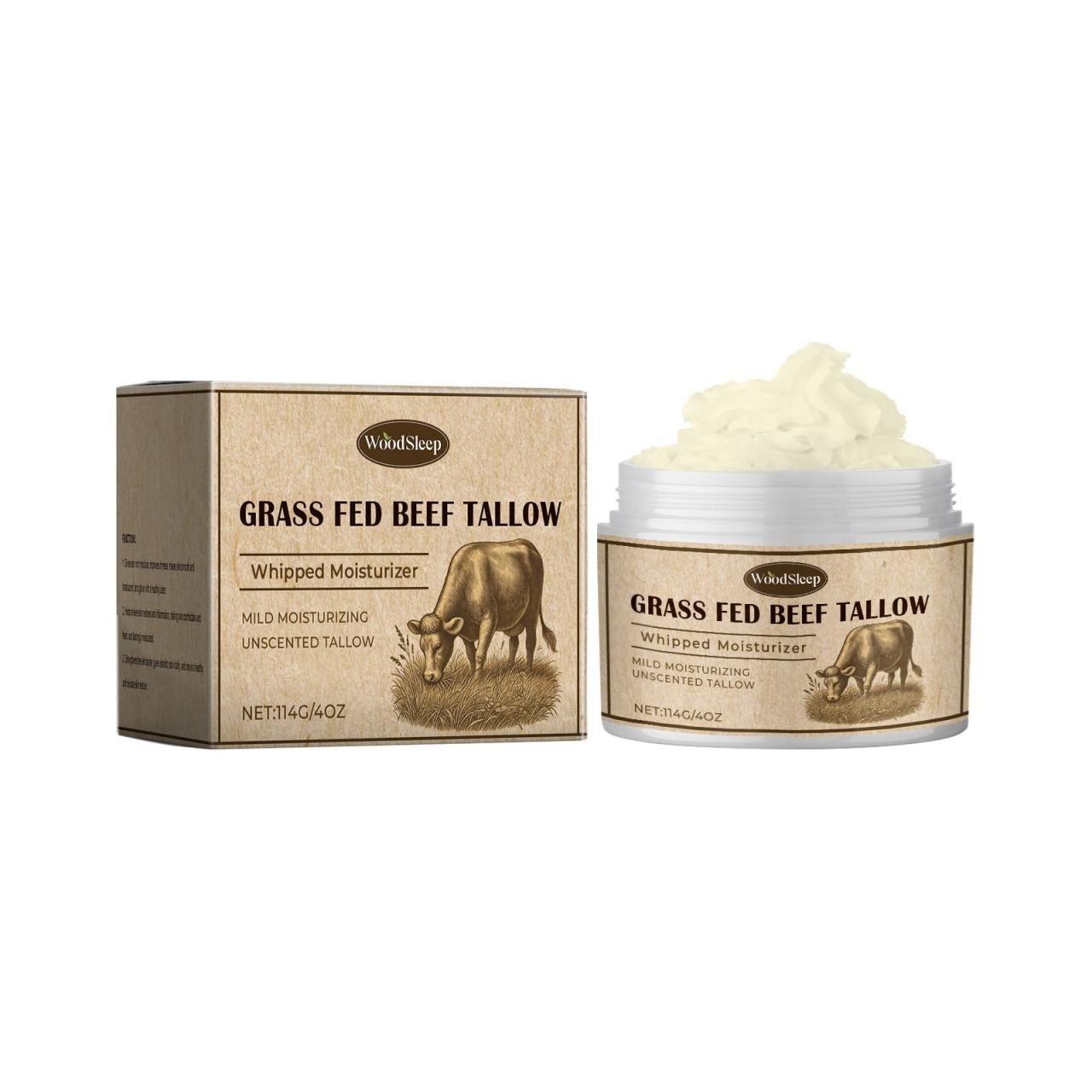
Beef tallow, a byproduct of beef processing, offers a unique perspective on natural skin care. Understanding its composition and how it interacts with skin can unlock its potential benefits. This section will delve into practical applications, showcasing its use in skin routines and highlighting its potential impact on skin health.
A Hypothetical Skin Care Routine
Beef tallow can be incorporated into a simple yet effective skin care routine. Imagine a daily regimen that includes a gentle cleansing with warm water and a mild soap, followed by patting the skin dry. Next, a small amount of warmed beef tallow is applied to the face and body, massaged gently into the skin until absorbed. This routine, practiced consistently, could potentially improve skin hydration and elasticity over time.
Chemical Composition and Fatty Acid Profile
Beef tallow is primarily composed of saturated and monounsaturated fatty acids. Its precise composition varies depending on factors like the breed of cattle and the processing methods. The dominant fatty acids typically include palmitic acid, stearic acid, and oleic acid, each playing a crucial role in skin health.
| Fatty Acid | Chemical Formula | Percentage (Approximate) | Impact on Skin |
|---|---|---|---|
| Palmitic Acid | C16H32O2 | 20-40% | Contributes to skin barrier function and hydration. |
| Stearic Acid | C18H36O2 | 10-30% | Provides a moisturizing effect, contributing to skin smoothness. |
| Oleic Acid | C18H34O2 | 20-50% | Known for its moisturizing and anti-inflammatory properties. |
Molecular Structure and Skin Impact
The molecular structure of beef tallow’s fatty acids directly influences its interaction with the skin. The long hydrocarbon chains of these fatty acids can penetrate the stratum corneum, the outermost layer of skin, effectively. The presence of these fatty acids helps restore and maintain the skin’s natural barrier function, promoting hydration and preventing moisture loss. The saturated fatty acids, in particular, are excellent at creating a protective layer on the skin’s surface.
The long-chain triglycerides (fatty acids) form a lipid matrix that helps lock in moisture, making the skin appear softer and smoother.
Beef Tallow as a Moisturizer
Beef tallow’s rich fatty acid content makes it an effective natural moisturizer. Its ability to form a protective layer on the skin surface helps retain moisture, preventing dryness and flakiness. This moisturizing effect is particularly beneficial for individuals with dry or dehydrated skin, as the fatty acids in beef tallow can effectively replenish lost moisture.
Potential Benefits on Skin Elasticity
Beef tallow’s composition may contribute to skin elasticity. The presence of essential fatty acids can help maintain the skin’s structural integrity. The fatty acids support the production of collagen and elastin, crucial proteins that provide firmness and elasticity to the skin. This impact, while not extensively studied, is a potential benefit that warrants further research.
Closing Summary

In conclusion, the question of whether beef tallow works for skin is complex. While anecdotal evidence and some preliminary research suggest potential benefits, robust scientific studies are still limited. Ultimately, individual results may vary. Thorough research, careful application, and a cautious approach are essential for anyone considering using beef tallow in their skincare routine. We hope this comprehensive exploration has provided you with a clearer understanding of this unique ingredient.



